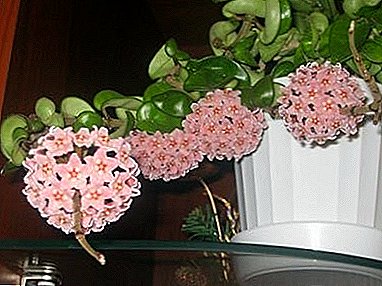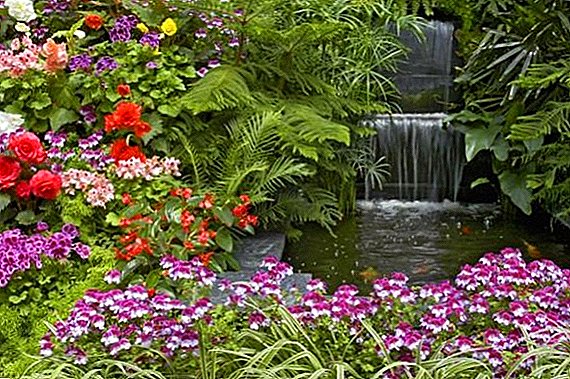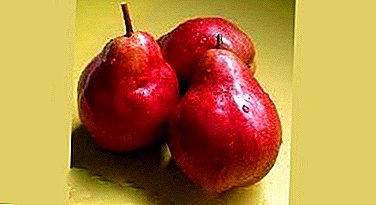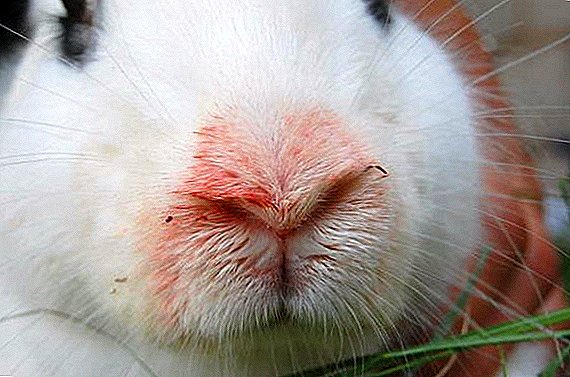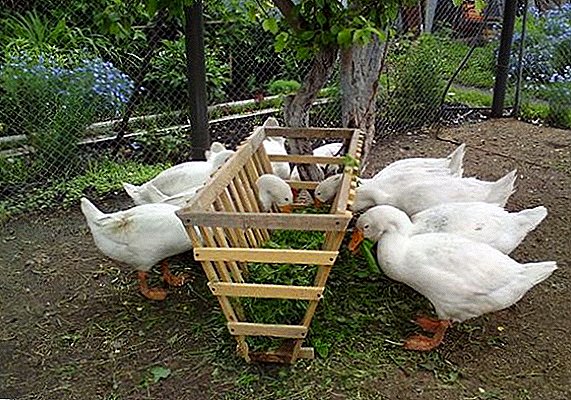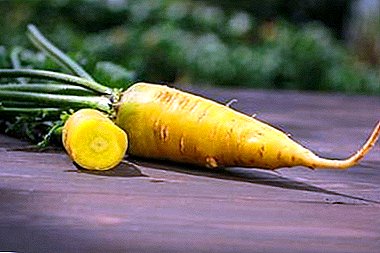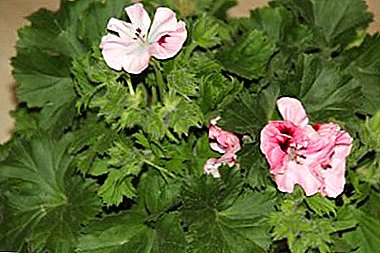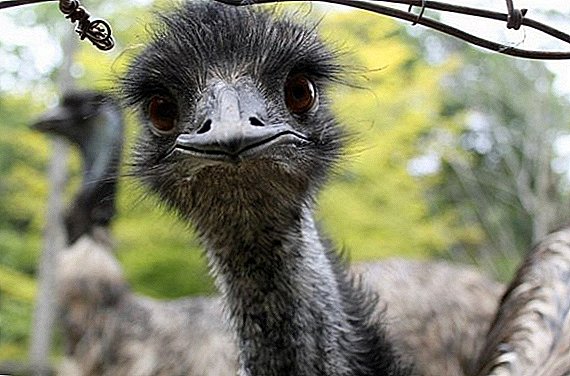 A lush, elegant shrub covered with snow-white flowers - this is what a plant called Spirea Vangutta, popular with gardeners, looks like. In addition to the spectacular appearance of its second advantage is ease of care. Such a combination makes this plant ideal for keeping experienced and beginner plant breeds. Spirea Wangutta is widely used in landscape design, often as a decoration of a country site. During flowering produces a stunning honey aroma. About how to grow white beauty in his yard, let's talk further.
A lush, elegant shrub covered with snow-white flowers - this is what a plant called Spirea Vangutta, popular with gardeners, looks like. In addition to the spectacular appearance of its second advantage is ease of care. Such a combination makes this plant ideal for keeping experienced and beginner plant breeds. Spirea Wangutta is widely used in landscape design, often as a decoration of a country site. During flowering produces a stunning honey aroma. About how to grow white beauty in his yard, let's talk further.
Botanical description
The history of this plant began in 1868, when as a result of selection of two types of spirea (Cantonese and three-bladed) a beautiful plant with long branches was obtained. This decorative deciduous shrub belongs to the Pink family, grows up to 2.5 m, has a very thick, wide in diameter, spreading and lush crown. 
The leaves are painted in a dark green shade on the upper side and in light green with a bluish bloom - on the back side, up to 4 cm long, with a toothed edge, of a rhombic shape. Autumn change color to purple or yellow.
Flowers are very small, from 0.5 to 0.8 cm in diameter, with yellow centers, form a lush spherical inflorescence 2-2.5 cm in diameter. For the first time the plant begins to bloom at the age of 2-3 years.
Familiarize yourself with the main species of spirea, as well as learn about the peculiarities of cultivation of such species as "Bumalda", Japanese, "Grefsheym", birch, "Snowmaund".
During the flowering period (from the second half of June to the second decade of July) last year's shoots are densely covered with white flowers. Sometimes there is re-bloom at the end of summer. Spirea Vangutta is an excellent honey plant, and the bee product from its flowers has a pleasant floral aroma and taste.
Distribution and habitat
Spirea Vangutta grows in the northern hemisphere of our planet: in Asia it grows in latitudes above the Himalayan mountains, in Europe the shrub is found in forest-steppe, forest and semi-desert natural zones, as well as in the subalpine mountain belt. On the territory of America spread above Mexico. 
Prefers areas with sufficient sunlight, nutrient soil, tolerates cold.
Did you know? Spiraea bark served as the raw material for the creation of acetylsalicylic acid or aspirin known to all now.
Use in landscape design
The spectacular and unusual shrub was not paid attention to by landscape designers, therefore, spirayu is often used to create compositions.
So, in landscape design the plant is used for such purposes:
- to create a hedge;
- in single compositions;
- for decorating the lawn;
- in compositions with other shrubs.
Since the plant survives well in an urban environment, it is often planted on the territory of industrial enterprises, children's and urban institutions, near motorways and just on city streets. 
Spirea Vangutta is perfectly combined with a variety of plants: with low flowers (peonies, roses, lilies, asters) and with coniferous species (spruce, thuja, juniper). Often, spirea is used to zoning space or to shift accents, for example, if it is planted near a fence or structure.
The plant responds well to shaping, so it is often used in classic "strict" compositions. It is a good alternative to willows for planting near water bodies.
Growing and caring for plants
Looking at the snow-white, lush shrub, naturally there is a desire to admire them on your site. Planting and growing a plant is not so difficult - then we will tell you how to create the most optimal conditions for Vangut's spirea.
Conditions of detention
If you decide to grow a snow-white beauty in your yard, the choice of location becomes one of the main and most important questions. 
At the same time, one should pay attention to its illumination - although it is not a critical criterion (Wangutta spirea grows well even in shaded areas), but for abundant and regular flowering it is advisable to plant bushes in well-lit areas. It is impossible to plant spirea in the lowlands, where rainwater and snow often accumulate.
In addition, it is necessary to take into account the dimensions of the above-ground part and the root system in an adult bush: the spiraea cannot be oppressed, since it has a superficial, but very sprawling root system. The distance between the bushes should be at least 1.5 m.
Important! Spirea Vangutta has a high resistance to urban air (smog, high gas pollution and pollution), so it can be planted without fear in the city.
Soil and fertilizer
This type of spirea shows particular demands on the soil: it must be fertile and rich, air and moisture permeable, light and loose. The pH level should be in the range of 6-7 units. 
Optimal are the turf and leafy land. The following mixture is ideal for soil preparation: 2 parts of sod land, 1 part of sand and peat.
If the soil does not meet the requirements at the site, you can adjust its composition during planting:
- in fat, "heavy" soil (chernozem, loam) it is necessary to make sand or peat;
- for the enrichment of depleted soils will need organic and mineral fertilizers;
- Soil acidity can be reduced with wood ash, lime, or lime.
With high soil fertility in the area, you can do with one dressing per season; for poor soils, you will need at least two dressings: before flowering and after autumn pruning. 
It is necessary to use both organic and mineral mixtures:
- Organic Submitted after trimming shrubs. Fit chicken droppings or cow dung. Pre-mix you need to insist at least a week, then mix 1 part of organic with 10 parts of water. Fertilizer should be applied after careful watering, preferably in the evening. The amount of fertilizer is calculated from the age and size of the bush: for young plants up to 0.5 m, half a bucket will be enough. For adult large bushes will need a couple of buckets.
- Mineral blends. Introduced in early spring before flowering. Optimal purchase ready store mineral fertilizers. They must be added to the soil based on the calculation: 70 g per 1 square. m
The mineral fertilizers include such as "Master", "Kemira", "Sudarushka", "Ammophos", ammonium nitrate, "Plantafol", "Azofoska".
Watering and moisture
This plant tolerates drought well, besides, the moisture remains for a very long time under the lush sprawling branches of the bush. However, one should not allow hardening and cracking of the soil, otherwise lush flowering is not expected. Soil moistening should be regular, but not abundant. 
For adult plants, watering about 2-3 times a month is enough, for one bush you will need 1-2 buckets of water. In the period of extreme heat and prolonged drought, watering should be intensified based on the state of the earthy coma. Young plants require more frequent watering.
To moisten the soil you need to use soft settled water of summer temperature. After moistening, be sure to mulch the soil with peat, sawdust or grass.
Did you know? In Ancient Russia, spirea shoots were used to create whipstocks, later they became the material for the manufacture of weapons ramrod.
Relation to temperature
The shrub is not whimsical to temperature indicators, has a high frost resistance, for the period of winter months it can even do without shelter. However, if the temperature in your latitudes reaches -45 ° C in winter, it can be fraught with the destruction of the bush. 
If there is a risk of very low temperatures, the shoots of Vangutta spirea should be tied in a bundle, pinned to the ground and covered with leaves or other covering material. Young plants that are under 3 years old need an obligatory winter shelter.
Plant reproduction and planting
In the overwhelming majority of cases, Wangutta's snow-white beauty is propagated by cuttings, since the seeds have an extremely low germination rate (about 5%). In the southern latitudes, planting is allowed in the autumn, since the rooting of the seedlings is quite good, and the risk of freezing is low.
In the middle lane and more northern latitudes, spring planting of shrubs is practiced. If you buy seedlings, pay attention to such moments - seedlings should be young, strong and healthy, without leaves, with green bark, as well as good buds. They should be planted before their blooming. 
The action algorithm for landing is as follows:
- At the selected place, dig a hole with dimensions of 50 * 50 * 50 cm. Now you can leave the landing site for 2-4 days for ventilation. If you plant several plants for a hedge, keep a distance of 1-1.5 m between the holes.
- On the day of planting, prepare seedlings: soak in water for a couple of hours, inspect the roots and, if necessary, remove the damaged ones, find the place of the root collar.
- When loamy soils be sure to make a thick layer of drainage, for this you can use expanded clay or broken brick. The thickness of the drainage is about 15-20 cm.
- Prepare an earth mixture according to the composition indicated above.
- Pour a layer of soil on the drainage layer, then place the seedling so that the root neck is at the level of the ground layer. Fill the pit with the remaining soil. Then the ground should be slightly tamped, watered abundantly (1-2 buckets of water will be needed) and mulched with peat.
Important! Optimum weather conditions for planting shrubs are cloudy day and even rainy weather.
Another method is reproduction by layering. 
To do this in the spring, during the period of foliage blooming, you need to select a few shoots, pin them to the ground and sprinkle with soil. The tip of the shoot should be cut to stop growth, the ground as needed to moisten.
In the fall you can get a ready-made plant for transplanting. By the way, spiraea responds well to transplantation, especially in the autumn.
Pruning
Pruning is a very important step in the care of spirea shrubs, if you neglect this procedure, your beauty will quickly lose its shape, upper shoots will crush and bend down the lower branches, and young shoots will become thin and weak, inflorescences will be small and rare.
Since this species blooms in summer, pruning can be done in spring. The procedure is carried out in 4-year-old and older plants. After winter, you can prune the tips of the shoots affected in winter. To do this, the shoot is shortened to the first large buds. 
Also removed are thin, weak, inconveniently located branches. Radical removal of old branches is carried out 7 years after planting, then you need to annually remove some of the old branches, thus updating the shrub. In this case, the branches are removed at ground level.
Possible difficulties in growing
When growing Vagutta spirea, gardeners most often face two problems:
- the plant does not bloom;
- the bushes dry shoots.

Their reasons may be the following circumstances:
- Lack of flowering. Remember that plants start to bloom after a couple of years of life, so perhaps your bush is just too young. If the reason is not aged, it is worth reviewing the care of it: lack of sunlight, insufficient watering (especially in the heat), prolonged absence of pruning are frequent causes of the absence of snow-white flowers.
- Drying of shoots. The reason may be an attack of pests. In this case, it is necessary to remove absolutely all the dried-up shoots, treat the cutting sites with garden pitch and apply the appropriate preparation for the fight against insects. Drying of the shoots can also occur as a result of the clogging of the roots. In this case, reduce watering, carefully soil the soil and apply the drug to stimulate root formation and improve the stress tolerance of the plant (for example, "Zircon").
Pests, diseases and prevention
This plant is practically not exposed to infectious, viral or bacterial diseases typical of shrubs. But sometimes spiraeus can be attacked by pests as a result of care errors or under special weather conditions. 
Next, consider how to deal with the most frequent pests of the bush:
- Spider mite It is not completely an insect, but it can significantly harm spiraea shrubs. Against him, a special group of drugs - acaricides. You can use "Neoron", "Aktellik", "Fitoverm" according to the instructions.
- Spireevaya and beet aphid. Twisted tips of the leaves, deformed tops indicate the attack of aphids. To combat the pest can be used drugs "Fufanon", "Akarin", "Aktellik".
- Rosana leafworm. May damage the plant: the larvae hatching in the bark begin to eat the shoots, leaves, flowers of the plant. To combat the need to use biological or chemical pesticides: "Fitoverm", "Calypso", "Clonrin".
- Balsam blue sawfly. It causes significant damage to the plant, eating young shoots. To destroy the caterpillars it is necessary to use the insecticide "Decis".
- Galitsa It may appear as a result of an excess of nitrogenous fertilizers or the absence of trimming a bush, and as a result, its excessive density. Externally, the gall midge is similar to a mosquito and looks quite harmless, however, it lays eggs under the bark of the plant, and the hatched larvae turn the tissues of the branches into dust. To control insects, insecticides should be used: Calypso, Karbofos. As a preventive measure, it is necessary to thin out shoots from time to time.

In general, the spirea Vangutta (like other species of this shrub) grows very well with minimal assistance and human intervention. Even in the absence of special care, spiraea lives up to 15–20 years, however, there are quite frequent cases when a magnificent beauty has lived to 40 years.
It is very easy to grow this ornamental shrub and will be able to even an inexperienced gardener.


